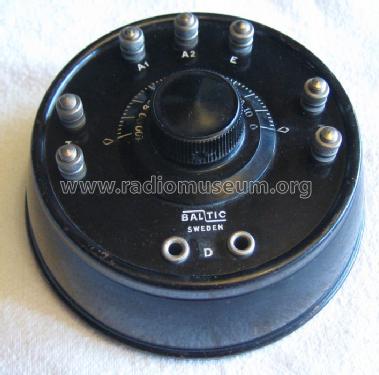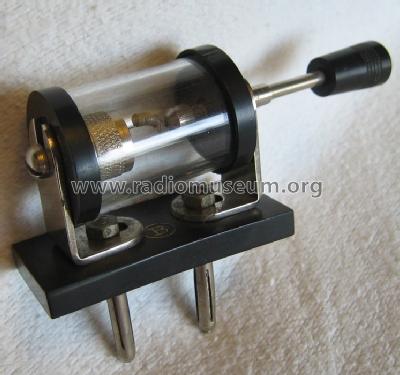Crystal Receiver M2
Baltic; Stockholm
- País
- Suecia
- Fabricante / Marca
- Baltic; Stockholm
- Año
- 1930 ??
- Categoría
- Radio de Galena (o de diodo pero no contiene tubos o transistores)
- Radiomuseum.org ID
- 85618
- Principio principal
- Detector de Galena o semi-conducteur; Crystal-detection 1 circuit (no tubes)
- Número de circuitos sintonía
- 1 Circuíto(s) AM
- Gama de ondas
- OM (onda media) solamente
- Tensión de funcionamiento
- No necesita alimentación
- Altavoz
- - Este modelo usa amplificador externo de B.F.
- Material
- Metálico
- de Radiomuseum.org
- Modelo: Crystal Receiver M2 - Baltic; Stockholm
- Anotaciones
- Konische Dosenform, Ø unten 120 mm, oben 100 mm. Material: Messingblech. Variometer-Abstimmung.
Es gibt von diesem Modell 3 Ausführungen für 3 Mittelwellenbereiche die sich nur in den Abstimmungs-Induktivitäten unterscheiden.
- Peso neto
- 0.3 kg / 0 lb 10.6 oz (0.661 lb)
- Procedencia de los datos
- - - Data from my own collection
- Autor
- Modelo creado por Christian Wirth. Ver en "Modificar Ficha" los participantes posteriores.
- Otros modelos
-
Donde encontrará 48 modelos, 26 con imágenes y 5 con esquemas.
Ir al listado general de Baltic; Stockholm
Colecciones
El modelo Crystal Receiver es parte de las colecciones de los siguientes miembros.
Contribuciones en el Foro acerca de este modelo: Baltic; Stockholm: Crystal Receiver M2
Hilos: 1 | Mensajes: 4
I have a receiver that looks exactly like the M2 although I cannot find any number on it. I have some remarks on this model:
I do not beleive it is as late as 1930. Baltic merged with AGA in the summer 1928 to form AGA-Baltic AB, a receiver marked Baltic would then be made before this. Baltic made advanced valve radios already in 1925-26, so even if they may have produced these crystal receivers in parallell with the valve ones, I believe it is an earlier product, my guess is as early as 1924-25.
My receiver has capacitive tuning, the condenser consisting of two copper plates with glimmer isolation between them, one fixed to the panel and one "spring loaded" that can be pressed against the fixed one by means of a threaded screw on the tuning knob axis. The frequency range is aproximately 270 to 550 kHz, the selectivity is quite bad and of course also the sensitivity as there is no amplification. The receiver would obviously need a strong local station to work reliably.
I enclose photos of my receiver and a wiring diagram.
Anexos
- Baltic crystal receiver (70 KB)
- Baltic M2 wiring (15 KB)
Bo Samuelsson, 26.Dec.06


